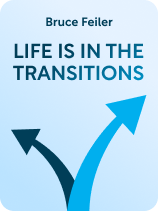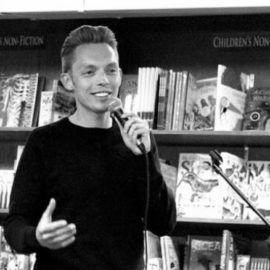

This article is an excerpt from the Shortform book guide to "Life Is in the Transitions" by Bruce Feiler. Shortform has the world's best summaries and analyses of books you should be reading.
Like this article? Sign up for a free trial here.
What is the “linear life”? How can believing in a linear life set you up for disappointment? How can you embrace a nonlinear life?
When we imagine our lives, we often imagine the ideal: college, career, family, and retirement. The truth is that most people’s lives aren’t that straightforward and include many life-altering disrupters and transitions along the way.
Keep reading to learn why you should embrace a nonlinear life, according to Bruce Feiler in Life Is in the Transitions.
Life Is Not Linear
According to Feiler, we often think of life in stages—such as childhood, adolescence, adulthood, and old age—with predictable transitions at predetermined points along that path. For example, you might expect to graduate from college in your early 20s, establish a career in your 30s, and retire in your 60s. Feiler calls this “the linear life,” and he argues it’s a myth: In reality, life doesn’t follow a linear path, and we can face transitions at any point. This myth is dangerous because it colors our expectations; we expect to move smoothly from one phase of life to another, so when we inevitably face curveballs (or don’t hit certain milestones at the same time as our peers), we fear that something has gone wrong.
(Shortform note: Experts explain that our expectations about life are determined by cultural life scripts, which are shared knowledge about life events: what someone belonging to a particular culture can expect and when events are supposed to happen. These cultural life scripts shape how we perceive and judge our progress in life, and they vary across societies—for example, Western people anticipate a midlife crisis, as Feiler notes, while people belonging to some other cultures don’t. Many people tend to feel distressed when their life trajectory doesn’t match their cultural life script, possibly because they feel they aren’t successful in ways their culture recognizes.)
Feiler argues that instead of clinging to the myth of the linear life, we need to embrace the idea that life is nonlinear. There is no predetermined path, so we should expect life-altering changes at any time. (Shortform note: Not all cultures view life as linear. For example, some Native American peoples see life as a cyclical journey of endless change rather than a straight line of progress from birth to death.)
According to Feiler, there are two types of life-altering changes that most people experience—adjustments and transformations. Let’s explore each.
Adjustments
Feiler says the first type of change is adjustments (he calls these “disruptors”). Adjustments are events that interrupt our status quo, making life feel different after they take place. These events can be positive or negative, and they might seem large or small from the outside—either way, they fundamentally change our daily lives. According to Feiler, the average person can expect to experience 30 to 40 adjustments in their lifetime.
In his research, Feiler found 52 kinds of adjustments that he says represent the full range of life changes, which he divides into five categories:
- Relationships: This category encompasses relationship changes of all kinds, from the births and deaths of loved ones to events like sexual abuse and addiction that affect how you relate to people.
- Health: This category includes all types of physical and mental illnesses and injuries, as well as recovery journeys.
- Identity: This category covers life events that affect your self-image as well as how others perceive you—for example, immigration, changes in criminal status, sexual and gender-related awakenings, and shifts in socioeconomic class.
- Perspective: This category covers experiences that change the way you see the world, including major sociopolitical events, extended travel, education, and shifts in religious belief.
- Career: This category encompasses changes in your work life—what you do for a living, how you feel about it, how you’re treated at your job, and joblessness and retirement.
| What Other Researchers Say About Adjustments Some experts refer to adjustments as “life events” and argue that most people experience hundreds of them over the course of their lives—not just 30 to 40. As Feiler argues, life events aren’t always dramatic—researchers recognize any occurrence that impacts psychological functioning, social status and relationships, and/or physical health as a life event. Feiler’s list of 52 adjustments, divided into five categories, may not encompass the full range of life events recognized by researchers. Additionally, some researchers use different categories to taxonomize life events. For example, one study found 121 major life events across 12 different categories: –Health, including reproductive health, illness, and changes in health habits –Financial, including major purchases, bankruptcies, and theft of property –Relocation, including local, domestic, and international moves and moving into or out of your family’s home –Legal, including being arrested or incarcerated or losing your driver’s license –Relationships, including engagements, serious arguments, and abusive relationships –Family relationships, including parenthood and family betrayals –Death, including deaths of friends, loved ones, and pets –Career, including unemployment, entrepreneurship, and work struggles and successes –Education, including graduations, transfers, dropping out, and being denied entry into a school or college –Lifestyle change, including joining the military and adopting a pet –Identity, including coming out as LGBT and having a coming-of-age ceremony –Societal, including natural disasters, wars, pandemics, and meeting celebrities Note that the division of any list of life events into separate categories is likely to be somewhat arbitrary. For example, Feiler lists sexual abuse under relationships, but experiencing sexual abuse can also impact your physical and psychological health, your identity, your perspective, and your career. |
Transformations
The second type of change Feiler describes is transformations (or what he calls “lifequakes”). These are events that redefine how we think about and derive meaning from our lives. Transformations are grander and more disruptive than adjustments, so much so that we use them to mark the passage of time. For example, instead of thinking of your life in terms of decades, you might think in terms of the time before and after you got married. What makes a life change transformative is relative: Some people go through major traumas that aren’t transformative because their view of life doesn’t fundamentally change; others are thrown onto an entirely new course by a seemingly minor event.
Transformations can fall into any of the five categories of adjustments that Feiler describes. They may be events you willingly choose, like getting sober or adopting a child, or events that are out of your control, like chronic illness. According to Feiler’s research, transformations tend to be personal rather than collective—for example, a personal diagnosis is more likely to be transformative than an international pandemic.
Why do certain life changes become transformative? Feiler points to moments of vulnerability as the deciding factor. He explains that when you experience an adjustment during a difficult time, multiple adjustments in a row, or a slew of adjustments all at once, they’re more likely to shake up your life in a profound way. For example, say you’ve been looking for a new job, but your applications keep getting rejected. The final rejection letter could become transformative if the stress and frustration from repeated setbacks have accumulated, leaving you feeling vulnerable and questioning your sense of self and purpose. Your heightened vulnerability could trigger a major career pivot where you decide to change fields or go back to school.

———End of Preview———
Like what you just read? Read the rest of the world's best book summary and analysis of Bruce Feiler's "Life Is in the Transitions" at Shortform.
Here's what you'll find in our full Life Is in the Transitions summary:
- How to deal with curveballs and obstacles in life
- The pattern that most of life’s disruptions follow
- How to rewrite your life story in a positive way






